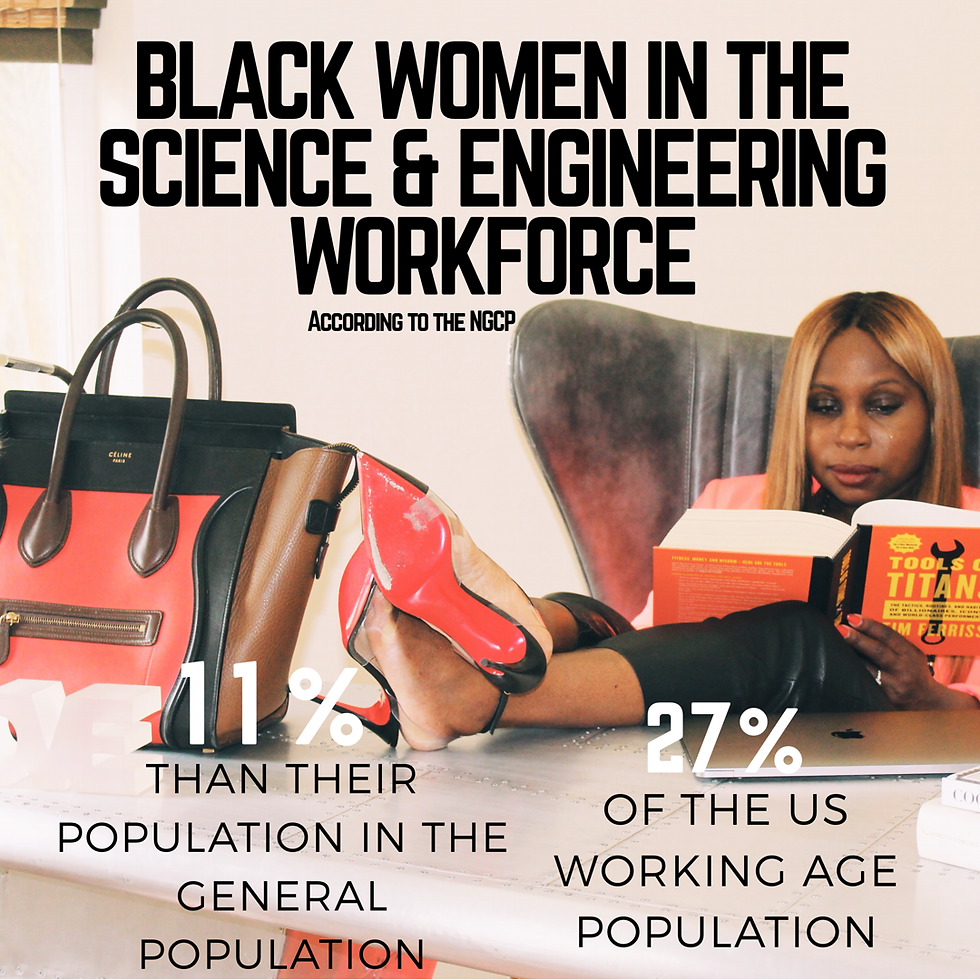These groups saw a need for Black girls in STEM, so they are trying to fix it
- A CULTURAL THEORY
- Apr 23, 2018
- 7 min read
Updated: Apr 24, 2018
By Dominique Dickerson
Laura Wilhem, like every mother, wants her daughter to be better than her in every way and to access opportunities she never had. One day she had a revelation while observing her child in an otherwise all-boys class.
“When she was playing with one of the robots, the boys there were kind of doing too much for her. Boys this age are loud and pushy and they want to do their own thing, and so my daughter didn’t want anything to do with it. It just wasn’t her cultural thing. The boys being loud and pushy and that made her not want to go forward. In no way did I think she felt inferior, I just think she didn’t want to be pushed around and in that environment,” she said.
Women have historically faced significant challenges in pursuing careers in Science, Technology, Engineering and Math (STEM) fields.

In 2011, Wilhelm launched Girls Get Science evenings with hopes to decrease the gender gap in the STEM fields.
Black women made up only 1 percent of employed scientists and engineers, while white women comprised 18 percent of the field, and black men made only 2 percent while white were leading with 55 percent, according to a 2009 study by the National Science Foundation.
Today, in a bid to increase more women and women of color in the field, there are a growing number of projects; organizations and programs trying to empower and create more opportunities for girls to thrive in STEM related fields.
Wilhem’s program is one such initiative.
The Girls Get Science series is an all-girl environment, where girls and parents get to meet and learn about the careers of leading women scientists and engineers that look like them.
“Girls tend to dismiss things and say, not fun, not for me, without even trying it, simply because the situation might feel uncomfortable to them. This Girls Get Science, is a way to say, hey it’s okay to give it a try and it is fun, doing really fun things. Part of it, is to get girls to explore, ” Wilhelm said.
In the evenings, girls who attend the event will be able to partake in many hands-on activities including robotics, digital storytelling and crime science. While the girls learn about STEM, their parents attend panel discussions about the experience of women and girls studying science.
“When we do Girls Get Science, we do try to get a good representation of different women scientists of different color, so girls can find someone that they can see as themselves in the future and they can picture, ‘that can be me too’. We started a girls-only camp, and that’s to encourage girls,” Wilhelm said.
A University of Washington’s 2011 study revealed that as early as the second grade, both girls and boys are more likely to associate math with boys, rather than girls.
“A lot of times, girls are just more socially aware, they want to do the things that their friends are doing. With boys, they tend to just want to do what they want to do. This girls-only camp is to make sure that girls know that there is going to be other girls there to hang out with,” Wilhelm continued.
In addition to Girls Get Science evenings, Wilhelm also spearheads The Great Adventure Lab (TGAL) summer camp program.
According to The National Summer Association, a non-profit dedicated to closing achievement gaps by increasing summer learning activities; American students lose an equivalent of two months of grade-level math during the summer.
Hundreds of STEM-based camps across the country give students the chance to learn coding, develop apps, and robots, at a time when they might otherwise be sitting by their pools.
Located in Silver Spring, M.D., TGAL tackles indoor and outdoor activities including Lego robotics, electronics, physics, 3-D design, video game programming and more.
TGAL has taught more than 10,000 kids to write their first programs, wire fire circuits or build and explode their first volcanoes.
“With the summer camp, we try to make it so that it doesn’t feel like too much like school, but it does kind of slant into classes,” Wilhelm said.
While there are programs, which work to get girls and girls of color interested in STEM, getting them on a track to a career in the field is equally important for advocates.
The U.S. science and engineering workforce has become more diverse, but according to The National Collaborative Project, statistics prove that several racial and ethic minority groups continue to be significantly underrepresented.
Black women make up a smaller share of science and engineering workforce (11 percent) than their population in the general population (27 percent of the U.S. working age population.)

The National Girls Collaborative Project’s (NGCP) vision is to bring organizations and professionals in STEM to engage girls in these subjects.
“Our role and value is to help connect programs with one another, so that they can better serve girls within their programs. That certainty and most defiantly includes programs that are focusing on reaching underrepresented and girls of color within STEM,” director of strategic partnerships for the NGCP Erin Hogeboom said.
On a national level, the NGCP has a network with over 36,000 programs.
“We have collaboratives in 41 states. Sometimes there are four states in one; for example, Washington, D.C. is the Mid-Atlantic Girls Collaborative Project. That includes, Delaware, Virginia, and Maryland,” Hogeboom, a former Peace Corps volunteer said.
Each collaborative has a defined region, acting as a hub for local programs. These programs are designed to coordinate resources and reach girl-serving STEM programs in the community.
“This is also a great way for parents to stay current on girl-serving STEM activities in their respected communities,” Hogeboom continued.
Another issue that women of color in particular may encounter in their careers is the presence of mentors.
According to recent research from the National Society of Black Engineers and the Society of Women Engineers, women of color experience difficulty advancing in their careers due to the lack of role models in engineering companies. Mentors demonstrate that success is possible for individuals who look similar to them, and many provide direct assistance to others by serving as mentors.
As a member of the Diversity Working Group for the University of Pennsylvania School of Dental Medicine and a former trustee for the National Dental Association, Dr. Joan Malcolm believes in giving back and helping the next generation.
She has mentored student dentists and student dental assistance.
“Mentoring opens pathways to achievement for young people through encouragement. Mentoring can be as simple as taking a kid to see a science movie, anything is motivation, “ Dr. Malcolm said.
Dr. Malcolm also provides shadowing opportunities at her South Jersey practice for many students who have gained valuable exposure to dentistry.
Hogeboom concurs with Dr. Malcolm.
“It is really important that girls of color see people that look like them in these potential career pathways so that they can actually imagine what it would be like working in their fields,” she said.
Hogeboom continued, “One of NGCP main initiatives that we organize our work around is www.fabfems.org./ This is our second data base of women in STEM, mentor and role models. This specifically focuses on girls in STEM and for women looking to become role models and their area. Via, you local, parents, girls, and programs can initially search up women interested in being STEM role models.”
The NGCP puts a lot of emphasis on why role models matter with a collaborative effort with www.Techbridgegirls.com. The role models matter project with Tech Bridge also brings resources to mentors and girl-serving organizations.
The median annual earnings for women in Science, Technology, Engineering, and Math fields are $64,000 (versus $78,000 for men), and only 3 in 10 (28.8 percent) STEM workers are women.
According to the Insitute for Women’s Policy Research, women’s underrepresentation in STEM fields may also be a factor in the gender-patenting gap. Although women have more then quintupled their representation among patent holders since 1977, fewer than 1 in 5 of all patents had at least one-woman inventor in 2010.
In 2015, (WoC,) an organization to curb generational poverty prior to womanhood was formed to mobilize and advocate for underserved girls to gain STEM resources.
By breaking down barriers to advance girls of color in STEM, Jeanose Lexima, founder of WoC, defines her organization as “essentially the power of women coming together to change outcomes that particularly affect STEM.”
“What sets us apart is that we are tackling girls from the bottom, low-income girls. This area here, in Washington D.C. has a lot of kids in need of our resources,” Lexima said.
WoC envisions creating resilient communities that eradicate the cycle of poverty through continuous learning.
STEM college majors on average earn $65,000 while non-STEM majors earn about $15,000. With the lack of resources in low-income areas, many girls of color don’t get the opportunity to pursue a career in these fields.
A report from NWLC (National Women’s Law Center) and the NAACP Legal Defense and Educational Fund examines the challenges African American girls face in education, including the lack of adequate STEM resources in schools.
“Living in D.C. for over twenty years, what I realized is that the educational system is where it all happens. So many parents I see that want to see their children do great things, but just don’t have the resources. We see how hungry the girls are, and we are here to provide resources for a long-term perspective,” Lexima said.
WoC has partnered with local organizations, assisting homeless schoolgirls ages 6-16 years old, to ensure they obtain adequate resources to thrive. WoC has already impacted over 100 girls and families in Washington, D.C., Maryland and Virginia area since it’s founding in 2015.
“The fire in these kids, the interest and how they’re capable of doing their own thing is amazing to me. And it’s sad that they do not have access to many things. What people need to understand is, these kids have gone through so much. They are self-starters, and being able to witness that leadership and curiosity in them is so important.”





Comments